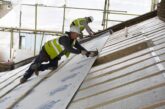
Forterra has launched a U-value calculator to help the construction industry meet increasing Part L regulations, aimed at reducing carbon emissions.
Understanding Part L and the new regulations
The construction industry is facing increasing regulations aimed at reducing carbon emissions and improving energy efficiency. Since June 2022, new Part L requirements have taken effect, pushing construction towards zero carbon, with even more rigorous standards expected in 2025 under the Future Homes Standard. But what does Part L entail, and how can builders ensure compliance?
The rationale behind Part L and the Future Homes Standard
An estimated 40% of all emissions in the UK are linked to the built environment, and the construction sector will therefore play a crucial role in tackling climate change. Part L is designed to help significantly cut the carbon emissions from new builds by 31% compared to previous standards.
For typical dwellings, Part L adopts a holistic approach to reducing emissions, incorporating both the building’s fabric and its additional services, such as heating, into the overall calculation. This comprehensive approach includes the adoption of structural design principles which can offset emissions, as well as low or zero-carbon heating systems and photovoltaics such as solar panels.

By focusing on structural elements, a builder or architect can comply with Part L regulations without having to rely on additions to the property as a whole. A critical focus of the new regulations is therefore on structural elements that improve what’s called ‘thermal bridging’, a term that refers to the way heat is lost at the junctions between building elements. This heat loss is measured by a ‘PSI’ value, which good structural design attempts to minimise.
Forterra
Forterra’s products support this fabric-first, structural approach, emphasising the building’s materials to achieve energy efficiency via the inherent design of the building rather than relying on extraneous additions. This approach ensures long-term sustainability and compliance with energy standards. A range of products and tools are designed to help builders meet the Part L requirements efficiently.
Forterra’s U-Value Calculator
To aid in meeting these requirements, a U-value calculator is available on the website. This tool allows builders to select wall-products based on specific U-value demands, simplifying the selection process and ensuring compliance with regulatory standards. The calculator is accessible here: https://www.forterra.co.uk/technical/u-value-calculator/

Jetfloor
This insulated flooring system has been a market leader since its introduction in 1982. The product integrates thermal insulation with structural performance, making it an ideal solution for meeting modern Building Regulations.
Jetfloor’s modular design means the thickness and grade of insulation can be adjusted to meet specific U-value requirements for individual houses or developments. This flexibility ensures that builders do not have to alter their designs to accommodate the system. Instead, it adapts to the design, offering a tailored approach to each project. The system also utilises Forterra’s Thermalite perimeter blocks, which enhance the thermal efficiency and reduce the PSI-value – an important measure of energy loss at the junction between the ground floor and external walls, and therefore a game-changer in complying with Part L.

Derived from the traditional 18th-century suspended timber flooring systems – and by the ancient Roman hypocausts before them – modern suspended insulated floor systems have evolved to offer superior thermal performance. The Jetfloor system is a prime example, combining the benefits of suspended concrete floors with advanced insulation techniques developed in the 1980s. By focusing on the thermal performance of the building’s fabric, Forterra’s products ensure comfortable internal temperatures without the need for excessive heating.
Thermalite and Conbloc: Versatile solutions for various build types
Thermalite aircrete blocks and Conbloc aggregate blocks are another cornerstone of the product range, offering versatile solutions for different construction needs. Available in various densities, configurations, sizes, and finishes, these blocks can be used for solid walls, partitions, cavity walls, and separating walls. This versatility makes it easier for builders to achieve desired U-values across a wide range of build types.
Thermalite blocks, known for their excellent thermal insulation properties, help in creating energy-efficient building envelopes. The use of these blocks in combination with Forterra’s other products ensures that builders can meet and exceed the U-value targets set by the new regulations. Thermalite perimeter blocks, together with attention to junction details, help further minimise thermal bridging, ensuring better overall thermal performance. Builders must now submit detailed design drawings for junctions and provide on-site photographic evidence of proper construction to comply with the regulations.
Looking ahead: Future Homes Standard
While Part L sets the stage for improved energy performance, the Future Homes Standard in 2025 will raise the bar even higher, aiming for a 75% reduction in CO2 emissions compared to previous standards. Forterra’s commitment to innovation and sustainability ensures that builders are well-prepared to meet these future challenges.
Forterra’s comprehensive range of products and support tools make it easier for builders to meet the new Part L regulations. By offering advanced solutions like the U-value calculator, Jetfloor system, and Thermalite blocks, compliance with changing energy efficiency standards can be achieved. As the industry moves towards the Future Homes Standard, Forterra remains a trusted partner in the drive towards zero carbon construction, providing the expertise and materials needed to build the energy-efficient homes of the future.
For further information on Forterra visit https://www.forterra.co.uk/technical/u-value-calculator/







